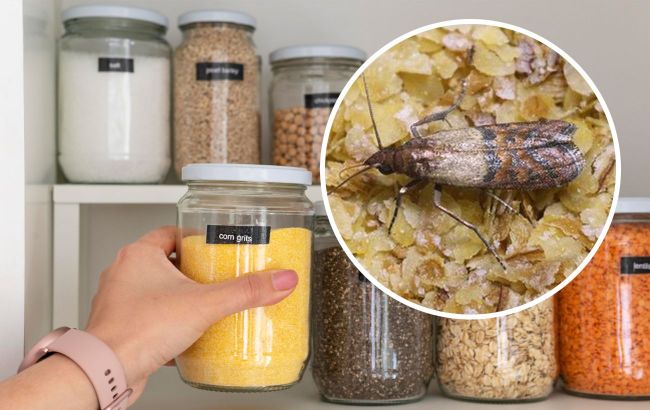Get rid of moths: Tips for clothes and pantry
 How to drive away moths (Collage: RBC-Ukraine)
How to drive away moths (Collage: RBC-Ukraine)
Moth infestation, whether in clothing or in food, is a quite common and unpleasant situation. Moreover, dealing with these pests can take up to a month. When getting rid of these annoying insects, it's important to follow certain steps, using simple methods.
Don't use chemicals in the kitchen
Avoid using pesticides to eliminate food moths to prevent toxic substances from entering food preparation and storage areas, thus avoiding poisoning.
Check products for spider`s web
Webbing is often the first visible sign of a food moth problem. You can usually find webbing in corners of pantries and closets, as well as on and inside bags of dry goods. Inspect adjacent dry goods for moth larvae.
Throw away all moth-eaten foods
Grain products such as flour, cereals, pasta, and baking mixes, as well as nuts, sweets, and dry pet food, are the favorite foods of food moths.
Larvae can hide along container edges, inside cans, and in unsealed packages.
Dispose of all found-infested products, immediately discarding them in an outdoor trash bin—remember, the longer moth-infested food stays in the kitchen trash, the higher the risk of moth spread.
Clean food containers
Be sure to wash food storage containers with hot, soapy water—hot water and soap will help eradicate moth larvae that are not visible to the naked eye and prevent further moth reproduction.
Vacuum cabinets
Clean thoroughly the cabinet where moths were present, removing and cleaning shelf liners. Vacuum the walls, baseboards, trim, floor, ceiling, and door, and dispose of the vacuum bag outside or clean the dustbin (for bagless vacuums).
Use vinegar for cleaning
Mix a solution of white vinegar and hot water in a 1:1 ratio and wipe down cabinets from top to bottom, inside and out, including corners, baseboards, floor, and storage containers.
Vinegar not only cleans effectively but also repels moths, and its acidity destroys moth larvae and eggs.
Use sticky traps
Hang sticky traps in the pantry to catch moths. Moths are attracted to the smell of fish oil, so you can apply a bit of oil to the traps to lure them.
Store clothing and products in airtight containers
Use tightly sealed closets, plastic containers, airtight bags, or similar items to prevent moths from getting inside and laying eggs.
Don't leave materials like wool exposed—put them in airtight garment bags, especially if you don't plan to use them for some time.
Avoid moisture
Keep clothing and other items in storage areas that are dry. Moths prefer a moist, humid environment.
So, avoid storing clothing or products in areas prone to moisture. Additionally, you can use moisture absorbers if needed.
Freeze moth-infested clothing
Another method recommended for dealing with moths is freezing clothes or items showing signs of moth infestation.
This method works best in winter, although there's an option to freeze items in the freezer. However, be aware of potential unpleasant odor.
Wash clothing in hot water
Wash clothing containing larvae or eggs. Use hot water and high dryer heat if possible—high temperatures and laundry detergent will kill the insects.
For clothing that cannot be washed or dried at high temperatures, consider freezing them.
Use herbs and spices
Moths have sensitive noses and will avoid odors they dislike, such as lavender, mint, bay leaves, cloves, rosemary, and thyme.
So, you can place dried herbs among products or hang sachets of dried mint leaves or lavender flowers in closets.
Another option is to dilute the essential oils of these herbs and spray clothing or use a diffuser with one or a combination of these oils. Additionally, you can use laundry detergent with mint or lavender essential oils.
Add cedar chips
The scent of cedar is another strong odor that moths dislike. Therefore, it's recommended to hang small, fragrant cedar chips in closets or among products.
However, remember that the strong cedar scent may overpower the smell of some loosely packaged products.
Check out also why your refrigerator might have an unpleasant odor and how to remove dark water stains without repainting.
Sources: The Spruce, Healthline.

